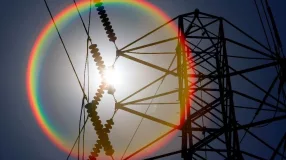Across the United States, our abundant and available supply of natural gas is helping Americans endure cold winters and other extreme weather events by providing a reliable source of heat and energy. As this infographic demonstrates, the U.S. natural gas infrastructure consists of over 300,000 miles of interstate pipeline and almost a half million producing wells. This system is also can draw upon 3 trillion standard cubic feet of natural gas in underground natural gas storage – enough to supply the natural gas needs of roughly one-third of U.S. households for a year. This diverse and widespread infrastructure helps ensure resilience to weather events and reliable delivery of natural gas to the communities that we serve.
Interstate pipelines make it possible for Americans to enjoy the benefits of this country’s abundant, domestic natural gas supply. These long-distance, high-capacity pipelines are the interstate highway system of the energy industry, providing the essential transportation link between distant natural gas producers and local gas utilities, industry, and electric generators. Pipelines have a remarkable track record of delivering natural gas safely and reliably to their customers.
The growth of U.S. natural gas supply and the development of infrastructure to deliver gas consistently has been a blessing for most Americans. With access to a cheaper, cleaner, and more reliable source of energy, people across the United States worry less about being left without heat or power during a frigid night.
If you live in New England, you don’t always enjoy those advantages. Political logjams have left natural gas infrastructure critically limited in this region. ISO New England, the regional power grid operator, has routinely warned that the region risks “rolling blackouts.” However, the region’s leaders have failed to heed these repeated alarms.
Unlike local gas utilities, most power plants in New England do not have long term transportation contracts with pipeline operators. This is important because firm contracts ensure the delivery of natural gas; pipeline customers with primary firm contracts received their natural gas 99.79 percent of the time between 2006 and 2016. During extreme weather events, local gas utilities fully utilize their contracted pipeline capacity to receive the natural gas needed to keep homeowners warm, leaving little surplus pipeline capacity for the power plants that gamble on non-firm transportation.
New England’s self-imposed isolation from domestic natural gas comes at a serious cost to the region’s consumers. In New England’s supply constrained market, electricity market operators must compensate for the pipeline capacity shortage by calling on generators fueled by coal or fuel oil. In some cases, this has also required using ocean going tankers to import natural gas from distant, and sometimes unfriendly, overseas sources. For instance, it is illogical for New England to import natural gas from Russia when one of the most prolific gas fields in the world is located a figurative stone’s throw away in nearby states. When you juxtapose the region’s prices with the U.S. average, New Englanders pay 29 percent more for natural gas and 44 percent more for electricity. This is due to a lack of infrastructure.
And the situation is not improving. In fact, it could become even more dire as illustrated by the ongoing debate over whether to subsidize the continued operation of the Mystic power plant and the Everett LNG terminal. As it stands, Exelon, the owner of both the power plant and LNG terminal, says that it is no longer economically feasible to keep the facilities operating and that they will close in 2022 without federal intervention. The Mystic 8 and 9 turbines alone make Mystic the second-largest power plant in New England. If the power plant and LNG terminal are shuttered, New Englander’s access to reliable and affordable power and heating will become even more constrained. This is yet another example of how expanded pipeline capacity would save the region from being on the brink of energy calamity.
The region’s political leadership has a role to play in addressing this critical need. A lack of pipeline infrastructure contributes to higher prices that New Englanders pay for electricity and during the cold and hot months, what they pay for heating and air conditioning. New England must also create a means for some entity, such as the regulated utilities that deliver natural gas and electricity to the region’s consumers, to invest in building out their infrastructure to take advantage of cheaper and cleaner domestic alternatives to their existing fuel mix in times of need.
New Englanders should not have to pay considerably more than the average American nor worry about whether they will have heat and power when they need it most. The region needs more, not less, pipeline capacity and our members are ready, willing and able to carry out this task as soon as the regional leadership rises to the occasion.
(Click inforgraphic to download)






